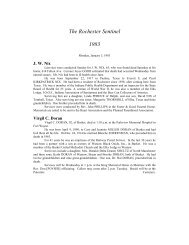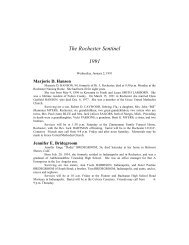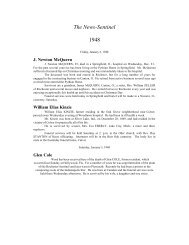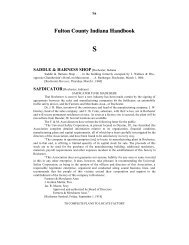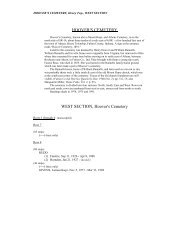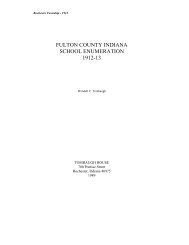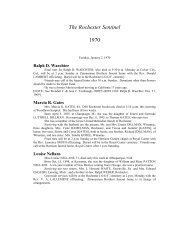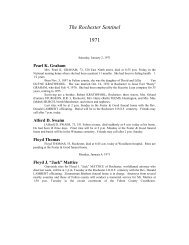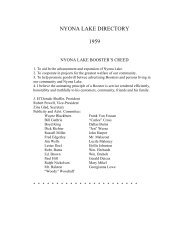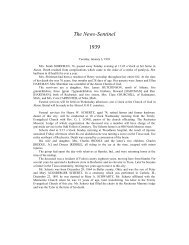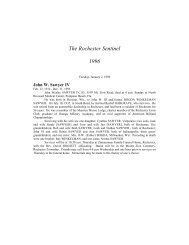Handbook N-P - Fulton County Public Library
Handbook N-P - Fulton County Public Library
Handbook N-P - Fulton County Public Library
You also want an ePaper? Increase the reach of your titles
YUMPU automatically turns print PDFs into web optimized ePapers that Google loves.
Pr<br />
[Rochester Sentinel, Saturday, July 3, 1920]<br />
PREHISTORIC BONES FOUND [<strong>Fulton</strong> <strong>County</strong>]<br />
MILLION YEARS OLD BONES FOUND<br />
The lower jaw bone and many other parts of the skeleton of what is thought to have been<br />
a mastodon, were unearthed Thursday afternoon, by the A. C. Davisson dredge at work on the<br />
Charles Yankee farm, five miles southeast of <strong>Fulton</strong> and are now on display in the Sentinel<br />
window.<br />
According to Dr. G. E. Hoffman, who examined the bones, the lower maxilary is one of<br />
the best specimens he ever saw. It weighs about 20 pounds. Practically the entire lower jaw is<br />
there, including two almost perfect teeth and several that had not yet come through.<br />
Million Years Old<br />
Dr. Hoffman places the age of the animal at almost six months, and declares that the<br />
bones may be a million years old, in as much as they were probably buried during the ice period<br />
and deposited here, which the glacier melted, ages ago. The find does not necessarily mean that<br />
the animal once roamed these parts.<br />
Other Bones<br />
The other bones unearthed, four in number, vary in size and weight, but none of them<br />
approach the jaw bone in these particulars.<br />
A number of such bones have been dug up about here in recent years, but it is doubtful if<br />
any more perfect specimens have been found. Many people inspected the aged relics today.<br />
[Rochester Sentinel, Friday, April 4, 1913]<br />
MILLION HEAR OLD BONES A MYSTERY<br />
“What is it” is the queston they all ask when they see the bones of the prehistoric animal<br />
dug up by A. C. Davisson dredge on the Charles Yankee farm south of <strong>Fulton</strong>. The bones are on<br />
exhibition at the Sentinel office and many of Rochester’s best educated man have been to the<br />
office to examine them.<br />
Not A Mastodon<br />
When the bones were first found, many said that they were from the skeleton of a<br />
mastodon, the ancestor of the elephant, but this theory was later destroyed by E. von Ehrenstein,<br />
who examined the bones. He said that the teeth of a mastodon have conical projections on the side<br />
and a groove down the center. The teeth now on exhibition are about seven inches long and two<br />
wide and are without a groove in the center.<br />
May Be Dinotherium<br />
Several men who examined the jaw bone said that it was probably part of the skeleton of<br />
a Dinotherium Giganteum, an extinct animal of gigantic size whose remains occur in the middle<br />
tertiary. This animal was remarkable for two large tusks set in the lower jaw. The jaw bone of the<br />
skeleton found, supports this belief, as two places are visible where the tusks may have been<br />
attached.<br />
Million Years Old<br />
Dr. Hoffman places the age of the animal at about six months, and declares that the bones<br />
may be a million years old, in as much as they were probably buried during the ice period and<br />
deposited here, when the glacier melted ages ago. The find does not necessarily mean that the<br />
animalonce roamed these parts.<br />
[Rochester Sentinel, Wednesday, April 9, 1913]<br />
ARE FOUND TO BE MAMMOTH BONES<br />
It is part of the skeleton of a mammoth, better known as the wooly elephant. This fact<br />
has been settled as to the origin of the lower jaw and other parts of a skeleton which was dug up<br />
on the farm of Charles Yankee and which is now on exhibition at the Sentinel office.




